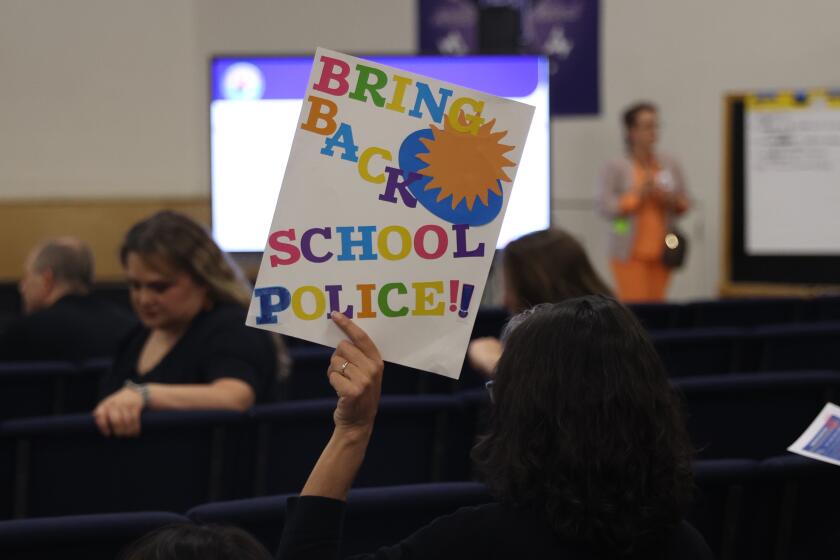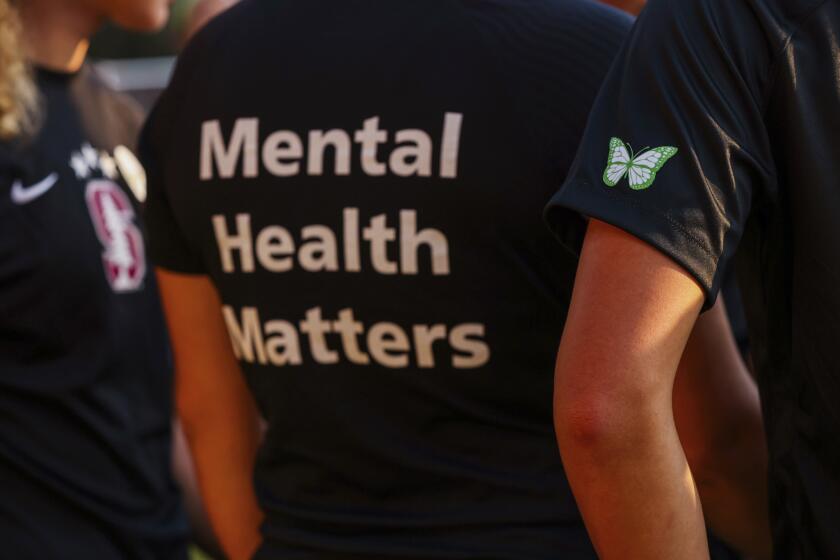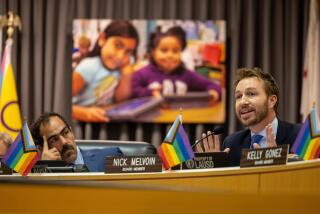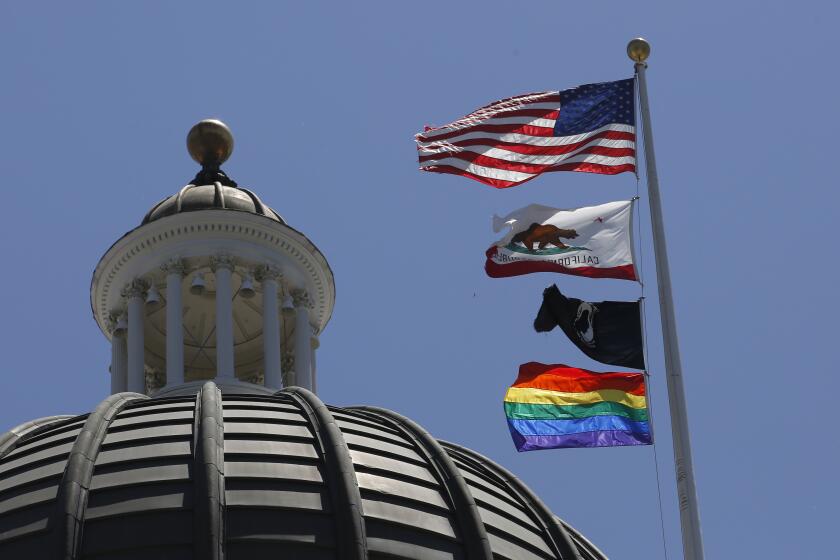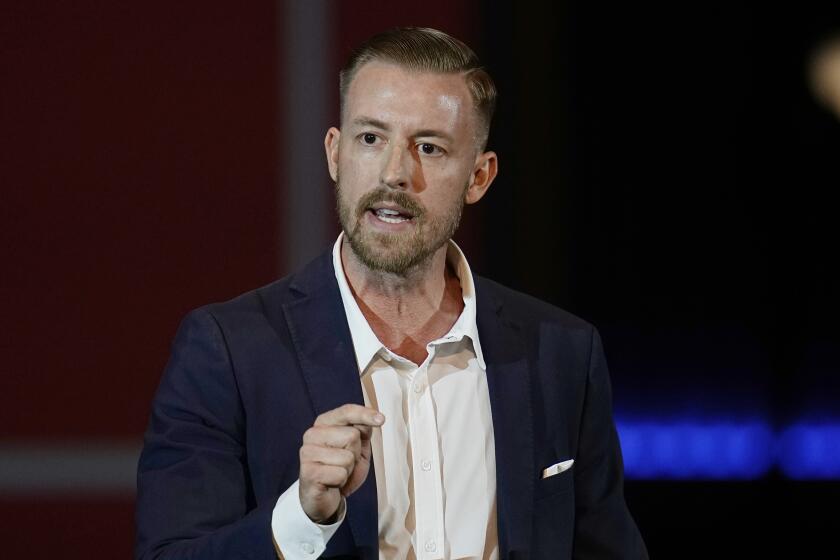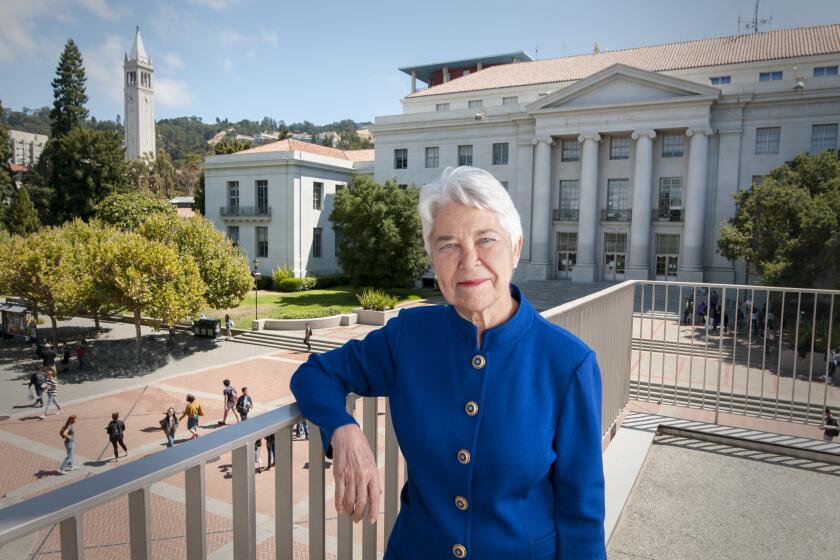LAUSD, fed up with kids distracted by social media, to consider cellphone ban

Los Angeles school officials on Tuesday — fed up with kids distracted by social media and concerned about abuses such as cyberbullying — are poised to join a growing number of school systems across the country that are banning the use of cellphones during the school day.
The hope is that a ban would lead to improved learning, less bullying, distraction and anxiety — and more meaningful communication with peers and adults.
Some parents, however, want their children to have cellphones for safety and communication and school administrators say the ban could be difficult to enforce.
The proposal was spearheaded by Los Angeles Unified School District board member Nick Melvoin.
“It’s been something I’ve been thinking about for years as I’ve just walked around campuses and seen kids on their phones and in class with their AirPods in,” said Melvoin.
Co-sponsoring the resolution are board President Jackie Goldberg and board member Tanya Ortiz Franklin. A fourth vote is required to pass the measure in the seven-member body.
The resolution would not immediately put a ban into effect. It directs staff to “develop and present to the public” policies that would prohibit student use of cellphones and social media “during the entire school day,” including lunch and breaks. Input would be solicited from “experts in the field, labor partners, staff, students and parents,” and details would come back to the school board for approval within 120 days.
With campus fights and a fatal shooting of a student near campus in spotlight, an internal task force calls for L.A. schools to have a police option, which anti-police activists oppose.
Elements to be worked out include different approaches for various age groups and a range of technologies, such as smartwatches.
Options under consideration include providing cellphone lockers or pouches that keep devices locked up and inaccessible until they’re tapped against a magnetic device when exiting campus. Technology also could be used to block access to social media platforms.
“More kids are getting phones at younger ages,” Melvoin said. “They’re bringing them to campus. And then I don’t remember as much phone-based drug sales. Or coordinating fights or some of the cyberbullying.” Key evidence at confidential expulsion hearings sometimes includes students’ text messages, he said.
The policy would go into effect in January 2025.
The largest employee unions did not offer an immediate reaction to the proposal when contacted last week.
L.A.’s principals and teachers need a policy aligned with current research, which shows that curbing phone use in schools leads to better academic performance and less cyberbullying.
One elementary principal said the policy would be overkill that would result in unnecessary work. He said about 25% of his students have smartphones, but they are a problem for fewer than 10; those can be dealt with on a case-by-case basis. The principal spoke not for attribution because he was not authorized to be interviewed.
Another elementary principal noted on the Facebook group Parents Supporting Teachers that she does not “see the need for Apple watches and cellphones on our young students. Now, as a parent of an LAUSD high school student who sometimes walks home, I DO see the need. It is a safety issue. All in all, I think they cause a lot of unnecessary drama on campuses, but need my HS student to have hers.”
AnneMarie Fulton noted on the Facebook group that her daughter will be starting middle school “10 miles from our home. I don’t want her to not have access to call me if needed. I’m strict on phone usage anyway, but taking that ability to contact away from a child doesn’t exactly seem right.”
There are also parents and employees who support the proposal.
Parent Mimi Hess referenced the Jonathan Haidt book “The Anxious Generation,” which makes the case that cellphone use is harming middle and high-schoolers.
“I very much hope that the LAUSD board passes a total cellphone ban in schools,” Hess said. “Simply put, they make kids more depressed and just plain dumber.”
District high school teacher Terri Derrickson Barraza wrote in a social media post that she “would love to see some type of ban on cell phones BUT ONLY if the district is going to back up the ban with logical consequences. If we are passing a ban with no backbone simply for PR reasons, it just makes my job harder.”
The resolution did not specify a penalty, but the most obvious response to a violation would be for a phone to be confiscated for a period of time deemed appropriate.
Adolescents who have dealt with cyberbullying and body dysmorphia due to their time spent online offer tips for their peers on how to navigate these spaces.
Although Melvoin acknowledges that his own observations about the harms of cellphones are anecdotal, the board resolution cites research in line with the proposed policy.
The resolution cites a national survey on drug use and health by the Substance Abuse and Mental Health Services Administration that found that among those born after 1995, anxiety increased 139% from 2010 to 2020, coinciding with the rise in smartphones and social media.
Researchers note that a correlation between two trends does not mean that one caused the other.
In addition, the U.S. surgeon general wrote in a 2023 advisory that social media may be linked to a growing mental health crisis among teens.
The resolution also cites a report from the U.S. Centers for Disease Control and Prevention that 16% of U.S. high school students in 2021 said they had been bullied via text message or social media over the previous year.
While social media provide a convenient platform for bullying, it’s difficult to say how much that would change with a school-day cellphone ban, since the devices and social media would be available at other times.
Important to the district’s goals are long-standing lessons on “digital citizenship” at all grade levels. All students who are provided online access must participate in an internet-safety education program.
The pandemic took a harsh toll on U.S. teen girls’ mental health, with almost 60% reporting feelings of persistent sadness or hopelessness
Moreover, current policy sets out that “approved social media is to be used at school for educational purposes only and under the direction of a teacher or school leader. Home use of social media on district or personal electronic devices is limited to only sites approved by the district’s web filtering system.”
The resolution also cites a 2016 Common Sense Media survey that found half of teens feel “addicted” to their phones. A 2023 study of 200 students by the same group found that 97% of 11- to 17-year-olds used their phones during the school day.
The resolution also states that there is evidence that “limiting cellphone usage and social media access during the school day increases academic performance and has positive effects on student mental health.”
Districts and schools across the country have adopted policies restricting student smartphone use. In 2023, public schools in Florida began prohibiting student phone use during instructional time and blocking access to social media on district Wi-Fi. Oklahoma, Kansas, Vermont, Ohio, Louisiana and Pennsylvania have introduced similar legislation, according to the resolution.
California Assembly Bill 3216, introduced in February, would require school districts to adopt a policy to limit or prohibit the student use of smartphones while at school or under the supervision of a school employee. The law would go into effect July 1, 2026.
Misuse of cellphones
Some students are using cellphones to set up fights, film them and post the footage online. With no access to phones during the day, this misuse could be reduced.
“We’re finding more and more things are being arranged via Instagram direct message or texting during the school day,” Melvoin said.
The April 15 fatal shooting of a Washington Preparatory High School student appears to have been recorded on more than a dozen cellphones. The incident took place a couple of blocks from school.
Students also use cellphones to provide campus accountability, documenting student walkouts, misconduct by adults or poorly maintained or locked bathrooms.
Anti-police activists have concerns.
“In the past, some students have used phones to capture criminalization or police violence like incidents of arrest or pepper-spraying of students at schools, or [to] connect with their parents or lawyers/advocates when their rights were being violated,” said Joseph Williams, the director of Students Deserve, which recruits and assists student activists.
It could be argued that a new resolution is unnecessary, and the real issue is enforcement. More than three-quarters of the nation’s school districts, including L.A. Unified, already prohibit nonacademic cellphone use.
Under existing policy, L.A. Unified prohibits “the use of cellular phones, pagers, or any electronic signaling device by students on campus during normal school hours or school activities, excluding the students’ lunchtime or nutrition breaks.”
The policy was adopted in 2011, and Melvoin said it needs to be updated.
Under the policy, students are permitted to possess phones, pagers or electronic signaling devices on campus provided they remain “off” and are stored in a locker, backpack, purse, pocket or other place where they are not visible during normal school hours or activities.
More to Read
Start your day right
Sign up for Essential California for news, features and recommendations from the L.A. Times and beyond in your inbox six days a week.
You may occasionally receive promotional content from the Los Angeles Times.
